In this article you’ll learn, what are different types of engines used in the automotive industries. And also you can download the PDF file of this article at the end of it.
What is an Engine?
An engine is a machine designed to convert one form of energy into mechanical energy. Heat engines, like internal combustion engines burn their fuel inside the engine cylinder.
On the other side, external combustion engines are those heat engines that burn fuel outside the engine cylinder. These are steam engines.
The energy developed during the combustion of fuel is transmitted to steam which acts on the piston inside the cylinder. In internal combustion engines, chemical energy is stored in their operation.
The heat energy is converted into mechanical energy by the expansion of the gases against the piston attached to the crankshaft that can rotate.
Types of Engine
Basically, engines are classified into two types, which are: internal combustion engines and external combustion engines.
#1 External Combustion Engine
Typically, it is a heat engine (also known as a steam engine) generates heat by burning fuel outside the engine cylinder. This engine uses additional heat to create low-pressure steam that is then used in the turbine to generate electricity. Since the fuel is burned outside of the engine here, solid fuel is commonly used.
#2 Internal Combustion Engine
In an internal combustion engine (ICE), the fuel is ignited and burned inside the engine. The energy from the combustion is then partially converted into work by the engine. Examples of internal combustion engines include two- and four-stroke petrol and diesel engines.
Internal combustion (I.C.) engines come in many types, and different criteria are used to classify them.
Read also: A Comprehensive List of Car Body Parts [Names & Functions]
#1 Classification by Types of Fuel used
According to the type of fuel used, the engines are classified into three categories
- Petrol engine (or Gasoline engine)
- Diesel engine
- Gas engine
Petrol Engine
The petrol engine uses petrol for its running. Petrol or gasoline is a hydrocarbon, made up of hydrogen and carbon compounds. The air-petrol mixture is sucked into the cylinder during the suction stroke of the piston. The correct air-petrol mixture is obtained from the carburettor.

The mixture is compressed during the compression stroke, ignited during the power stroke, and the exhaust gases are pushed out during the exhaust stroke. A spark plug is fitted at the top of the cylinder, which gives a spark to ignite the mixture.
Diesel Engine
In these types of engines, diesel oil is used for its running. Diesel oil is light, with low viscosity and high cetane number. In the diesel engine, only air is sucked into the cylinder during the suction stroke and compressed to high pressure, and the compression ratio is as high as 22:1. Its temperature also rises by about 1,000°F.
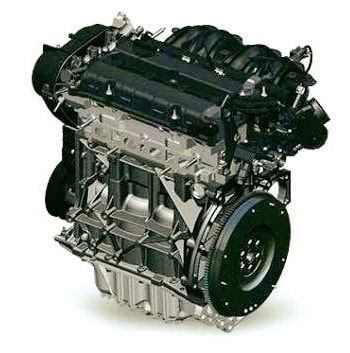
The diesel oil is injected by an injector at the end of the compression stroke which catches fire and burns due to the high temperature of the compressed air. No separate ignition system is required. The burnt gases expand pushing the piston down during the power stroke and finally, the gases are pushed out during the exhaust stroke.
Gas Turbine
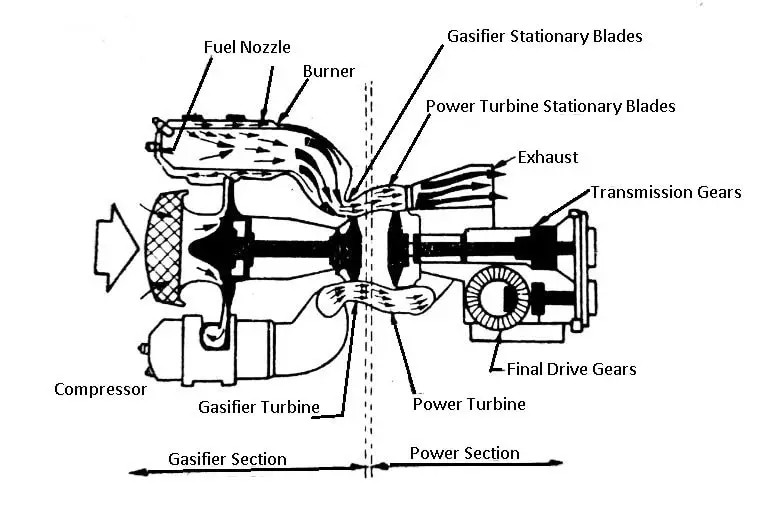
A gas turbine essentially consists of two sections-a gasifier section and a power section. The fuel used in a gas turbine can be gasoline, kerosene, or oil. The gasifier section burns fuel in a burner and delivers the resulting gas to the power section, where it spins the power turbine. The power turbine then turns the vehicle wheels through a series of gears.
The gasifier consists of a compressor with a rotor with a series of blades around its outer edge. As the rotor rotates, the air between the blades is carried around and thrown out by centrifugal force into the burner. Thus air pressure rises in the burner. The fuel is injected into the burner, where it burns and further raises the pressure.
You might also like: What is Camshaft? How It Works?
#2 Classification by Cycle of Operations
According to the cycle of operations, automobile engines may be of the following three types:
- Otto cycle engine.
- Diesel cycle engine.
- Dual cycle engine.
Otto Cycle or Constant Volume Cycle
Otto Cycle or Constant Volume Cycle. This cycle was introduced in practical form by German scientist Otto, in 1876, although it was described by French scientist Beaude Roches in 1862. The engines operating on this cycle are known as Otto-cycle engines. The petrol engines operate on this cycle.
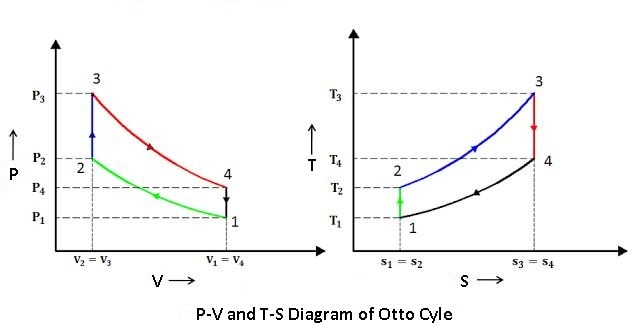
An I.C. engine does not undergo a cyclic change, but it is assumed here that the working medium is pure air which does not undergo any chemical change. The air is heated and cooled to undergo a cycle. It is also assumed that the ideal indicator diagram is strictly followed.
| The ideal Otto cycle consists of the following operations: |
| 1-2 Adiabatic compression. 2-3 Heat addition at constant volume. 3-4 Adiabatic expansion. 4 1 Heat rejection at constant volume. |
Diesel Cycle or Constant Pressure Cycle
Diesel cycle was introduced by Dr. Rudolph Diesel in 1897. The engines operating on this cycle are known as Diesel engines. The figure shows the p-v diagram for a Diesel cycle.
| It consists of the following operations: |
| 1-2 Adiabatic compression. 2-3 Heat addition at constant pressure 3-4 Adiabatic expansion. 4-1 Heat rejection at constant volume |
The Diesel cycle differs from the Otto cycle in one respect. In the Diesel cycle, the heat is added at constant pressure instead of a constant volume.
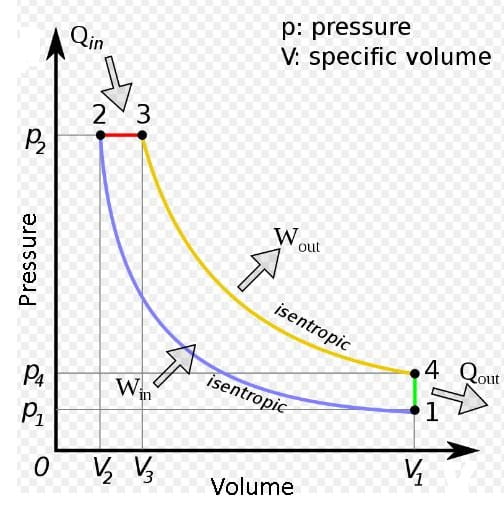
The air is compressed in the cylinder during the compression stroke from point 1 to 2. Now the heat is added at constant pressure from point 2 to 3, and then the air is expanded adiabatically from point 3 to 4. Finally, the heat is rejected at constant volume from point 4 to 1. The air returns to its original condition, and the cycle is complete.
Dual Cycle (or Dual Combustion Cycle)
In these types of engines, more time is allowed for the combustion of fuel in the Diesel engine without adversely affecting the efficiency.
The fuel is injected in the cylinder before the end of the compression stroke so that combustion proceeds partly at constant volume and partly at constant pressure. Such a cycle is known as Dual cycle. In fact, all Diesel engines actually operate on this cycle. The figure shows the dual cycle on the p-v diagram.
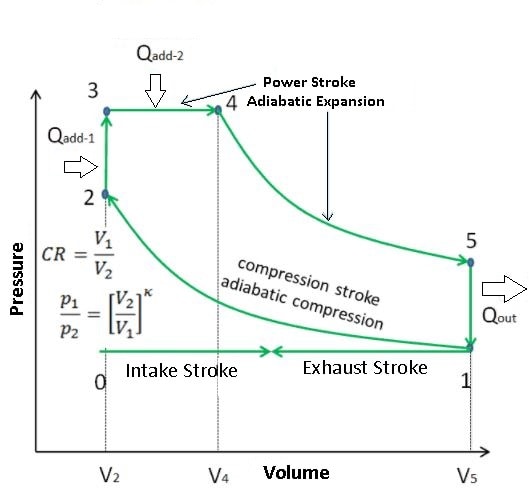
| It consists of the following operations. |
| 1-2. Adiabatic compression 2-3. Heat addition at constant volume 3-4. Heat addition at constant pressure 4-5. Adiabatic expansion 5-1. Heat rejection at constant volume. |
Because the fuel is injected into the cylinder before the end of the compression stroke in the dual cycle, it takes care of the ignition lag characteristic of the fuel.
You can read fully about these topics:
- Dual Combustion Cycle Processes with [P-v and T-s Diagram]
- Four Stroke Diesel Cycle Engine and Its Working [Explained with P-v and T-s Diagram]
- Four-stroke Otto-cycle Spark-Ignition Engine with [P-v and T-s Diagram]
#3 Classification by No. of Strokes per Cycle
According to the number of strokes per cycle, automobile engines are classified as
- Four-stroke engine.
- Two-stroke engine.
Four-stroke engine
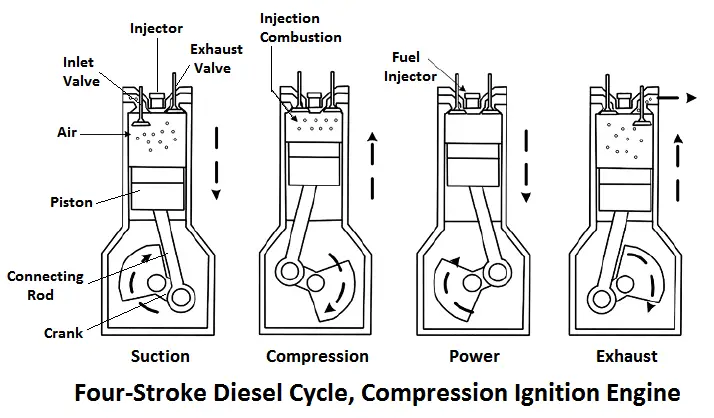
The four-stroke completes a cycle of operations during the four-piston strokes, namely suction, compression, power, and exhaust. These four strokes require two revolutions of the crankshaft. Thus, during every two crankshaft revolutions, there is only one power stroke of the piston.
Two-stroke engine
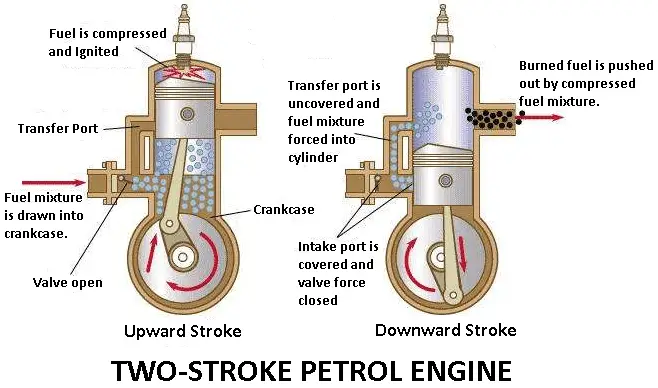
The two-stroke engine completes a cycle of operations during the two-piston strokes. These two strokes require one revolution of the crankshaft. Thus, during every revolution of the crankshaft, there is one power stroke of the piston. Therefore, a two-stroke engine produces twice as much horsepower as a four-stroke engine of the same size, running at the same speed.
In the two-stroke engine, the intake and compression strokes, and the power and exhaust strokes are, in a sense, combined. Two-stroke engines are used in motorcycles, Scooters. Four-stroke engines are used in cars, trucks, and buses.
Read more: What is the Function of a Connecting Rod? Parts, Types, & Uses
#4 Classification by Type of Ignition
According to the type of ignition used, modern automobile engines are classified mainly into two groups:
- Spark ignition engines.
- Compression ignition engines.
Spark Ignition Engine
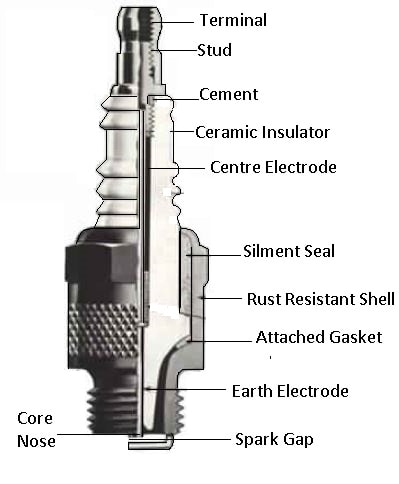
In a spark-ignition engine, a spark plug is fitted at the cylinder head, which gives an electric spark at the end of the compression stroke to ignite the fuel. Petrol engines are spark-ignition engines.
Read also: What is the Ignition System and 3 Different Types of Ignition System
Compression-Ignition Engine
In these types of engines, the fuel is ignited by the heat of compressed air inside the cylinder. There is no spark plug in it to give a spark. The air is compressed in the cylinder during the compression stroke relatively at higher pressure.
The compression ratio is also higher than that in the spark-ignition engine. Fuel is injected at the end of a compression stroke, which burns due to the heat of the compressed air. Diesel engines are compression ignition engines. Hot spot ignition engines are not practically used.
Read Also: What is Propeller Shaft? Diagram, Parts, Types, Functions [Explained]
#5 Classification by Number and Arrangement of Cylinders
The automobile engines may have one, two, three, four, six, eight, twelve, and sixteen cylinders. One-cylinder engine is used in scooters and motorcycles. The two-cylinder engine is used in tractors. Four and six-cylinder engines are used in cars, jeeps, buses, and trucks.
Comet trucks and buses have six-cylinder engines. American passenger cars have eight-cylinder engines. Twelve and sixteen-cylinder engines are also used in some passenger cars, buses, trucks, and industrial installations. The three-cylinder engine is also used in a foreign front-drive automobiles.
The cylinders can be arranged in several ways-vertical, horizontal, in a row (inline), in two rows or banks set at an angle (V-type), in two rows opposing each other (flat, or pancake) or like spokes on a wheel (radial).
Single Cylinder Engine
These types of engines are generally used for light vehicles like scooters and motorcycles. The maximum size of the single-cylinder engine is restricted to about 250-300 c.c. Higher engine size will require heavy engines due to the higher unbalance forces in a single-cylinder engine.
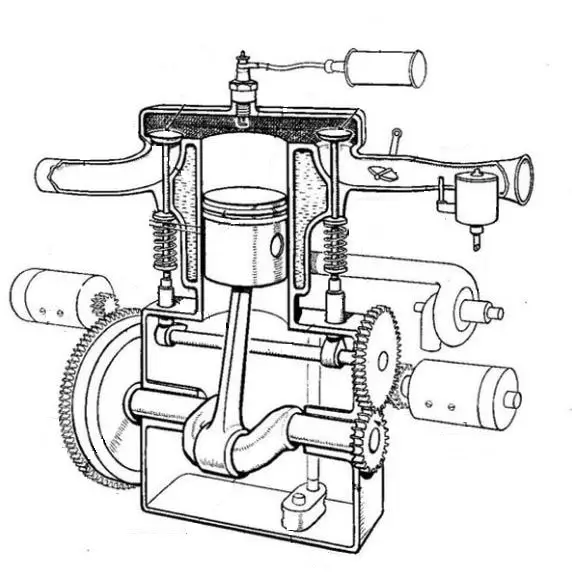
In one cylinder, there is one power impulse in two revolutions of the crankshaft. Thus, out of the four strokes of the pistons, the power is delivered in one stroke, and in the remaining strokes of the pistons, the power is consumed in overcoming the friction resistance of the moving parts. The torque distribution during a cycle is uneven, resulting in rough working and vibrations.
Since there are only one piston and one connecting rod, which reciprocates with no working parts to counterbalance their weight, the one-cylinder engine does not have mechanical balance. However, the engine is balanced to some extent by using the counterweight attached to the crankshaft, and also by using a flywheel so heavy that its momentum produces a comparatively steady movement.
The fluctuations in the engine speed cause vibration, even in the best designs of one-cylinder engines. Hence cylinder engines are undesirable for use in motor vehicles.
Two-Cylinder Engine.
This types of engines are used mostly in tractors. They are also used in a small German automobile and DAF of Holland car. The arrangement of the cylinders in the two-cylinder engines may be of three types
- In-line vertical type
- V-type
- Opposed type
Three-Cylinder Engine
The three-cylinder engine is used on a front-drive car, where the differential is located between the engine and the transmission. The three cylinders are placed in line. This is a two-stroke cycle engine. The crankcase in this engine serves as an intake and precompression chamber.
Each cylinder has its own sealed section of the crankcase. Thus, the main bearings that support the crankshaft are of the sealed type, so the crankcase is divided into three separate compartments, one for each cylinder.
Four Cylinder Engine
Four-cylinder engines are mostly used for ordinary cars. The torque obtained is much more uniform than the two-cylinder engine because two working strokes per revolution are obtained.
The cylinders of a four-cylinder engine are arranged in the following type:
- In-line Vertical Type
- V-type
- Opposed type
Six and Eight Cylinder Engine
Six and eight-cylinder engines give much smoother torque and higher horsepower. The cylinders of these engines are also arranged in three ways in line, V and opposed type, in the same way as in the four-cylinder engines. In line 6, cylinder engines and V-8 engines are almost universally in use. The angle between the cylinder rows in V-8 engines is usually kept at 90°.
V-8 engines with smaller V-angles have also been made, but the valve operating mechanism is complicated in them. V-6 engines have two three-cylinder rows that are set at an angle to each other. The crankshaft has only three cranks, with connecting rods from opposing cylinders in the two rows being attached to the same crankpin. Each crankpin has two connecting rods attached to it.
The V-8 engine has two four-cylinder rows that are set at an angle to each other. The crankshafts have four cranks with connecting rods from opposing cylinders in the two rows attached to a single crank pin. Thus, two rods are attached to each crankpin, and two pistons work to each crankpin. The crankshaft is usually supported on five bearings.
Read also: What V8 Engine (Eight-Cylinder Engine) and How It Works?
Twelve-and Sixteen-cylinder engines.
The arrangement of cylinders in twelve and sixteen-cylinder engines may be of the following types.
- V-type or pancake-type has two rows of cylinders.
- W-type has three rows of cylinders.
- X-type has four rows of cylinders.
The twelve-and sixteen cylinder engines have been used in cars, buses, trucks, and industrial installations. The only passenger car now being made with a twelve-cylinder engine is the Ferrari.
#6 Classification by Valve Arrangements
Automobile engines are classified into four categories according to the arrangement of the inlet and exhaust valve in various positions in the cylinder head of the block. These arrangements are termed as ‘L’ T, F, and T. It is easy to remember the word ‘LIFT to recall the four-valve arrangements. The I-head design is most commonly used in automobile engines.
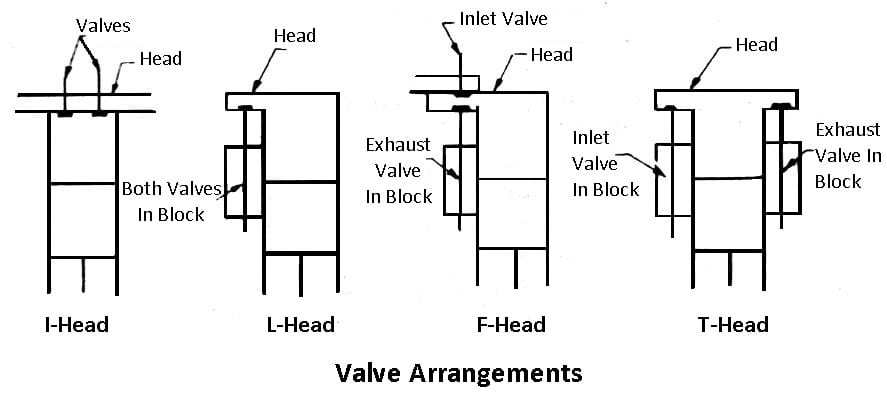
I-head engine
In I-head or overhead valve engine, the valves are located in the cylinder head. In-line engines usually have the valves in a single row. V-8 engines may have the valves in a single row or in a double row in each bank. Regardless of the arrangement, a single camshaft actuates all the valves.
Read also: Engine Valves: Types of Engine Valves, It’s Working and Valve Mechanism
L-head engine
In an L-head arrangement, the inlet and exhaust valves are located side by side and operated by a single camshaft. The combustion chamber and cylinder from an inverted L. All the valves for an engine are arranged in one line, except for V-8 L-head engines, which are in two lines.
In L-head engines, the valve mechanisms are in the block, and hence the cylinder head may be easily removed when required for overhauling the engine. Although the L-head engine is rugged and dependable, they are not particularly adapted to higher compression.
The I-head valve engine is more adaptable to a high compression ratio. In the I-head valve engine, the clearance volume can be reduced to a greater amount than in the L-head engine. In some I-head engines, there are pockets in the piston heads into which the valve can move when they are open with the piston at T.D.C.
F-head engine
This engine combines L-head and I-head engines, in which one valve, usually the inlet valve, is in the head, and the exhaust valve is in the cylinder block. Both sets are driven from the same camshaft.
T-head engine
The t-head engine has the inlet valves on one side and the exhaust valves on the other side of the cylinder. Thus, two camshafts are required to operate them.
Read also: Combustion Chamber: Types of Combustion Chamber and Cylinder Head
#7 Classification by Type of Cooling
According to the type of cooling method, the automobile engines are classified mainly into two categories:
- Air-cooled engines.
- Water-cooled engines.
Air-cooled engines
Air-cooled engines are used in motorcycles and scooters. In air-cooled engines, the cylinder barrels are usually separate and are equipped with metal fins which give a large radiating surface to increase the rate of cooling.
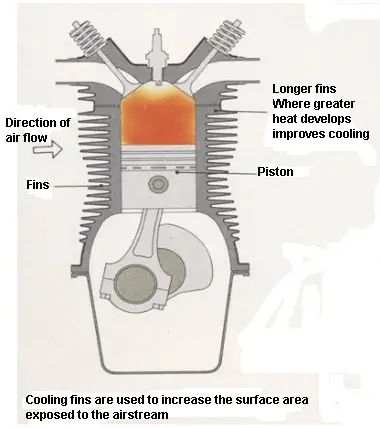
Many air-cooled engines have metal shrouds that direct the airflow around the cylinders for improved cooling. Since these engines do not use water, the problem of cold weather maintenance is eliminated.
Read also: Types of Cooling System In Automobile Engines (I.C Engine)
Water-cooled engines
These types of engines are used in buses, trucks, cars, and other four-wheeled, heavy-duty motor vehicles. These engines use water, with an antifreeze compound added to serve as the cooling medium.
The water is calculated through water jackets around each of the combustion chambers, cylinders, valve seats, and valve stems. After passing through the engine jackets in the cylinder block and cylinder head, the water is passed through the radiator, where it is cooled by air drawn through the radiator.
Evaporative cooling engines are not practically used.
Read also: What is Air Cooling System and How It Works In Vehicle
#8 Classification by Arrangement of Cylinders
Inline Engine
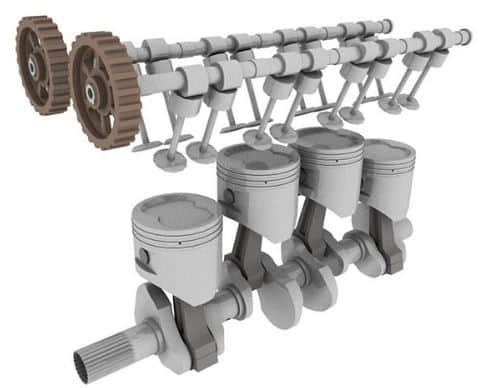
Simply put, an inline engine has all of its cylinders in a straight line. It is a reciprocating engine that consists of banks of cylinders, with each bank having any number of cylinders, although more than six are rare.
In this engine, the crankshaft and cylinders are arranged in a straight line. An inline engine is less expensive in comparison. Due to their small size, these engines are light.
V-type Engine
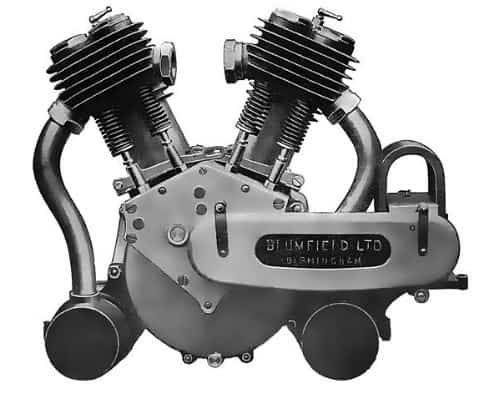
V-type engines have their cylinders arranged in two equal rows, or, to put it another way, in a V-like shape. This type is frequently used because it takes up a smaller space and can fit in most cars.
In this engine, the crankshaft and cylinders are positioned at an angle. V-engines have more parts than inline engines, which can make them more expensive. In addition, they are taller than a flat engine.
Radial Engine
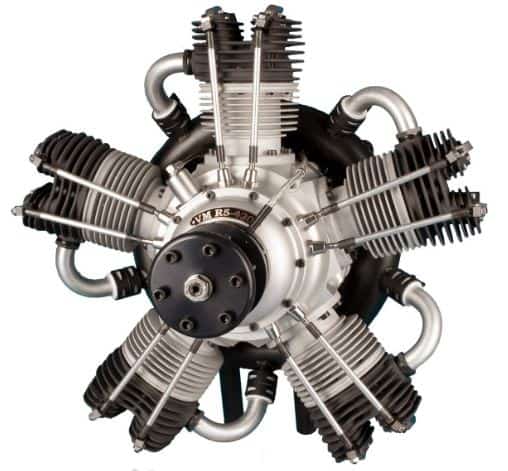
It is a type of reciprocating internal combustion engine in which the cylinders stick out from a central crankcase like spokes on a wheel. It is referred to as a “star” engine because it resembles a stylized star when viewed from the front.
In general, radial engines are more reliable. This is because it has a shorter crankshaft, a more straightforward construction, and produces less vibration. Before the gas turbine engine becomes the dominant option, it is often used for aircraft engines.
Opposed Piston Engine
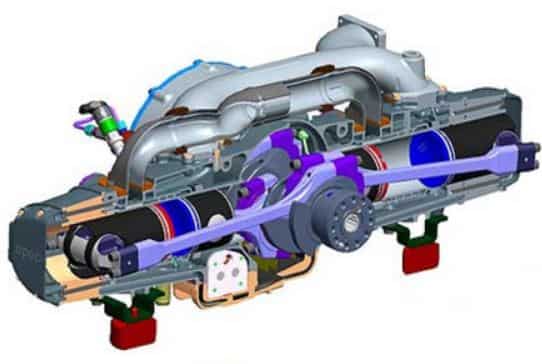
An opposed-piston engine is a piston engine without a cylinder head that has pistons at both ends of each cylinder. In this engine, cylinders are angled 180°, identical to a V-type but with a 180° angle.
Large-scale applications like ships, military tanks, and factories have traditionally used petrol and diesel opposed-piston engines.
Horizontal Engine
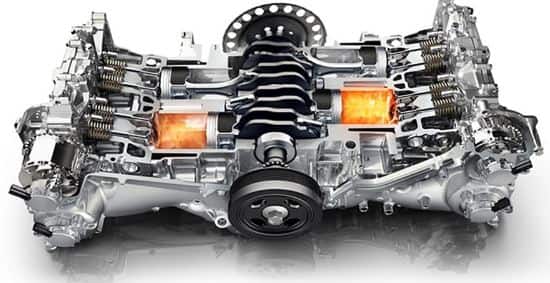
Instead of traveling in a V, like a V-6 or V-8 engine, the cylinders in a horizontal engine move horizontally with the ground. In this engine, the cylinders are located on either side of a central crankshaft. These engines are also known as flat engines. This is different from opposed-piston engines, in which two pistons share a central combustion chamber in each cylinder.
W-type Engine
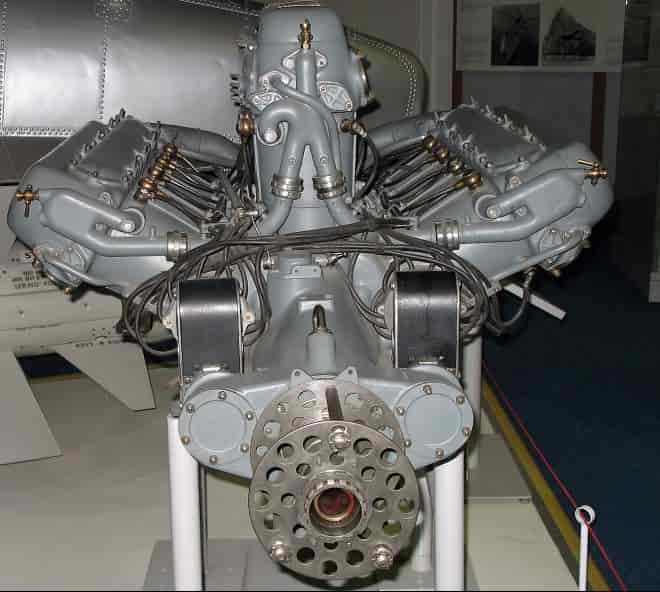
In W-type engines, the cylinders are arranged in three rows so that the arrangement is W-shaped. A W engine has three or four groups of cylinders connected to one or two crankshafts, unlike a V engine.
Due to their smaller size and increased power, W engines are used in heavy-duty vehicles, luxurious and exotic cars.
Reverse Cylinder Engine
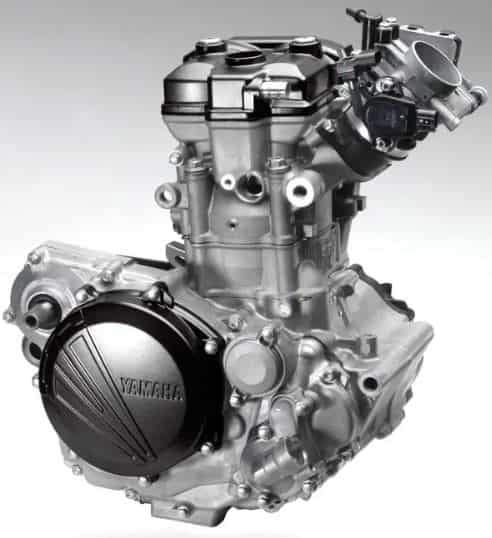
The cylinders of a reverse-cylinder engine are positioned opposite one another. Connecting rods and pistons operate at comparable speeds. It functions more reliably and evenly, and because of the way it’s set up, the anti-cylinder engine’s size grows.
That’s it. Thanks for reading. I hope you find this article helpful. If you have any questions about “Types of Engine” ask in the comments. Share this post if it’s worth sharing.
Subscribe to our newsletter to get notifications of our new articles.
Download the PDF file from here:
You might like to read more in our blog:
Very good and too much interesting vickypedi for understanding the out map as well as complete types of engine.
Thanking you.
You’re welcome.
In-Depth Concept. Thank you so much
You’re most welcome.
Very Useful.Thank You.
You’re welcome.
Good valueable knowledge. Great work Saif.
Thanks for reading.
Love it brilliant thank you
You’re welcome.
Fantastic Work. Its very useful for my exams. Pdf plz… Bro
Thank you so much
Thank you so much I have learned something and again it’s my great expectations that I would learn more from you.
You’re most welcome. Make sure you subscribe to our newsletter for future articles.